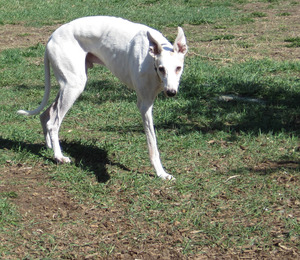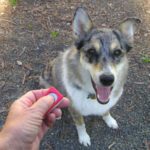Seeing your dog through a leg amputation surgery is a scary proposition for any dog owner, whether the amputation is due to disease or injury. I have personally seen two of my greyhounds (Apollo at age 10, and Mikey at age 11) through the surgery, and have spoken with many other dog owners as their dogs underwent this treatment. While I am not a vet, I can speak from a dog-owner’s perspective, and I hope to alleviate some fears about the leg amputation procedure by letting others know what kinds of things to expect post-amp.
— Supplies & Home Preparation
You will probably have very little time to prepare, since this is a surgery that is often done on an emergency basis. However, if you are able, these are some things to think about and supplies to gather.
Purchase an assistance harness (such as a Ruff-Wear harness). Some are made to measurements, so order this in advance to have on-hand when your dog comes home. It will help you help him get up and about during the period when he is still finding his balance. If you don’t want to order one, you can make one with some simple sewing. The most basic one is a rectangle of strong but soft fabric to wrap under the rib cage, with long nylon webbing handles on each end.
If you have slippery floors in your house, get some rugs. You don’t want your dog slipping and falling after surgery, while he is still learning balance. And many dogs will just flat-out refuse to walk on slippery floors.
If you have a lot of stairs, think about how you will negotiate these for the first few weeks post-op. You may want to set up a “recovery area” in the part of the house that has the fewest stairs, and prepare to keep the dog (and yourself) in that area most of the time post-surgery. If you have a few stairs to go outside, strongly consider purchasing (or constructing) a ramp with good traction. The dog will be able to do stairs eventually, perhaps even within a few days. But it’s safer in the long-run to limit the amount of stairs your dog climbs on three legs.
Stock up on some things you may need when the dog first comes home. Pediasure is good for a dog who does not have much appetite, for getting some calories into him. Chicken broth poured over food may stimulate eating. Gather some old t-shirts to cover the surgery site, some old blankets to put on top of the dog’s bed in case the wound is seeping. Maxi pads stuffed into the t-shirt can catch some seepage.
— Diet and Supplements
Get your dog on nutritional supplements. The strain on his joints is going to increase, so it’s a very good idea to get him on some glucosamine and chondroitin. Springtime makes a chewable “Joint Health” tablet. The same company also makes a “Longevity” supplement that can be used in conjunction with the “Joint Health” if desired. The Greyhound Gang sells powdered glucosamine and chondroitin that can be mixed into yogurt or food.
— Miscellaneous
Make sure the dog’s toenails are nice and trimmed, to minimize slipping.
Prepare yourself for what your dog will look like when he comes home. Join Tripawds.com for personal stories of amputations, often accompanied by photos and sometimes video. This group is great about giving advice to newbies from been-there-done-thats, so ask questions!
‘”‘”‘”-
Day of Surgery
You will need to fast the dog for around 12 hours pre-surgery.
Consider bringing your dog’s bed along, so that he will have a familiar place to recuperate in the ICU. Also bring one of your own recently-worn t-shirts (for your scent), some of your dog’s food, and some treats that he finds especially appealing.
If you desire, you can ask the vet’s office to provide you with frequent updates. But try not to worry. The surgery itself is actually a fairly low-risk procedure, since it does not involve any internal organs.
‘”‘”
Post-Op
Choose a facility that has overnight medical care!
They will probably keep your dog overnight 1-3 nights, depending on how he is recovering. They typically like to see the dog both eating and able to get himself up and move around a little bit before going home.
If, when you see your dog, his level of mobility is not something you are comfortable handing, you can ask them to keep him another night. They will generally let you visit your dog in the ICU, but perhaps not on the day of the surgery itself, as the dog will be sedated and resting.
Be prepared when you see your dog for the first time. He can sense how you are feeling, and if you are upset and scared, he will be too. Act like everything is normal, and he will feel better. It is still the same dog!
If he is not bandaged, the sight of the incision may be a shock, so prepare yourself for a very large incision, with swelling and possibly substantial bruising. Also prepare for him still to be potentially a little “out of it” from the sedation.
— Meds
The hardest thing for the humans to handle may be if the dog seems afraid, anxious, uncertain, or painful. Remember that some of these things (especially the anxiety) can be caused by the very medications that are helping with his pain. He may still not be “with it.”
Pain medications such as Fentanyl (this is a patch that is applied to the dog’s skin for 3-5 days post-op), Tramadol, hydromorphone, etc. are called “opiates,” and some dogs may be extra sensitive to these. They can very often cause restlessness, panting, anxiety, whining, and dysphoria (hallucinations). However, they are also often the most effective method of pain control.
If the side effects are too much to handle, talk with your vet about possibilities for different pain meds. Your dog will probably also be on an NSAID (non-steroidal anti-inflammatory drug) such as Deramaxx or Metacam. These may cause a little stomach upset, but will not cause the dysphoria of the opiates. Another option to ask about is Gabapentin.
If the side effects of the drugs are keeping the dog from getting rest, you can ask your vet for some Valium (diazepam). This can “take the edge off” the anxiety from the opiates. Some vets may also use Acepromazine, which really can knock the dog out. If you use Ace, start with a VERY small amount, and if that has not had the desired effect after 90 minutes or so, give a little more. This has a muscle relaxing effect, and will make it harder for the dog to walk. It can last 6-8 hours. It can also lower blood pressure, so ask your vet whether this is a concern for your dog.
It is very important that your dog be able to rest during the days after surgery, so it’s important to find a balance between pain relief and side effects of the pain medications.
Pepcid AC can help with tummy upset from the NSAIDs, too (although antacids should not be given with Gabapentin). He needs to feel well enough to eat something to keep his strength up. If need be, use the Pediasure or chicken broth to get some calories into him. And make sure he stays hydrated; offer him water often.
— Mobility
Your dog will require almost constant supervision during his first few days home from the hospital. The first night or two, you are unlikely to sleep much, so rest up before surgery and while your dog is in ICU. Make sure the schedule the surgery at a time when you will be able to take a few days off work when he comes home: preferably someone who is physically able to lift the dog unassisted.
How mobile your dog will be when he comes home depends on the individual dog. Some dogs are getting around relatively well within a day or two. Others will take a week, 2 weeks, even a little longer to really figure it out. In the meantime, you can assist your dog with a harness (as mentioned above), or even with a long bathtowel looped under his ribcage. This can help you bear some of his weight and keep him on balance.
You will almost certainly need to assist him at first with pottying. Some dogs may find this type of help difficult to accept, especially those who are not used to doing their business while on-leash. Try to give him as much “space” as you can while still being there to support or catch him if he wobbles.
As he gets more confident, it’s up to you to keep him safe. He may forget and try to do things he did pre-amputation, like jump on/off the bed, run too soon, go down stairs without assistance, etc. It is very important that he not fall hard during his recovery period, or he can injure his surgery site (or one of his “good” legs).
Older dogs have a longer adjustment period in general. Also, paradoxically, the dogs who had the best use of their “bad” leg pre-amputation have longer recovery times. Dogs who were not bearing weight on the bad leg have already started to adjust to walking on 3 legs. The amputation is less of a transition for those dogs, and actually eliminates the pain caused by that bad leg.
Mobility generally improves as more of the sedation drugs and pain drugs leave his system, and as the swelling goes down.
He will learn it! He just needs rest, practice, and supervision and encouragement from you.
If you must leave your dog alone soon after surgery, put him in an area where he cannot hurt himself, and away from your other dogs. If possible, get someone to check on him if he is alone for a long period, or hire a dogsitter.
— The Surgical Site
The bandaging that your surgeon does will depend on his/her preferences. My vet recommends a compression bandage left on for the first 5-7 days after surgery. This prevents fluid buildup at the surgery site, which can cause pressure on the sutures and oozing of the wound. If this bandage gets wet, it will need to be changed.
After the bandage comes off, you can protect the area by putting a t-shirt on the dog. You can use a human t-shirt, tied up at the waist so not to trip the dog or get peed on. Or you can use a t-shirt made for dogs.
You can expect to see edema (swelling) around the compression bandage, down around the dogs chest and groin area. You will also see edema in the remaining leg. If this seems excessive or increases very rapidly, check with your doctor. It may remain for a week or so. As time goes on, everything moves “south” — The swelling in the chest will decrease but the swelling in the leg will increase. You can massage the leg gently, or use a heating pad on it to encourage circulation.
You will also see some redness and bruising. Again, if it seems excessive or increases very rapidly, check with the doctor. This should also dissipate over a few days to a week. It looks a lot worse than it is.
One more note on bruising ‘” If your dog has had extensive bruising, you can expect to see some orange urine for a day or two as his body breaks down the extra blood. You might immediately think “internal bleeding” but if he is otherwise okay (normal heart rate and respiration, not overly lethargic, normal temp) then this is unlikely. For a quick test, check his gums. If you press your thumb against it, the white spot you leave should turn pink again almost immediately.
You will need to watch for infection. Your dog will probably either be on an oral antibiotic, or have been given a long-acting antibiotic injection during surgery, and infection is more likely to occur after those meds have finished.
‘”‘”
The First Couple Weeks
Dog parents who have been through amputations with their dogs often report the “two weeks of hell,” during which the dog is recovering from surgery and taking lots of medications. Your dog is almost certain to behave oddly during this time, both as a result of the meds, and also of just adjusting to his new situation.
He may seem unable to get comfortable, or just not seem to know what he wants. He may stand up, lie down, stand up, lie down, wander aimlessly. He may pant a lot or seem anxious. He may cry out or whine even if it seems that nothing is touching his sore spot. He may refuse foods that he otherwise loved, and eat things you didn’t expect.
Unless any of these are extreme, they are probably within the normal range. Most of these do pass after a couple weeks, and your dog’s pre-surgery demeanor will gradually come back. Some people report that once the pain meds are gone, it’s like somebody turned the lights back on and the dog gets back to normal. DO NOT withhold pain meds, though, because he needs them!
Dogs can have phantom limb pain, just like human amputees do. This is *real pain* even though the limb is gone. It’s nerve pain. One of the best meds for this is Gabapentin. Ask your vet about it if you think your dog is having this type of pain.
You may also see what can only be called “depression” in your dog. It is tiring, both mentally and physically, to feel “off” for days on end — whether that means painful, uncomfortable, drugged-up, nauseous, or just “not-quite-right.” In most cases the depression doesn’t last long, and you can help your dog by getting him back into the normal swing of life. Encourage him to do his favorite things. But try not to fuss over him too much, or he will sense your worry and reinforce the idea that something is very wrong.
Within 2-3 weeks, your dog should be moving around with near-normal confidence (although it is best not to allow him to run yet, if he feels up to it). Before that time, you might feel yourself questioning whether you’ve done the right thing for him. But remember, you made the decision out of love and the best information you had. He’ll get through it, and you’ve given him the best chance of pain-free life that you could.




